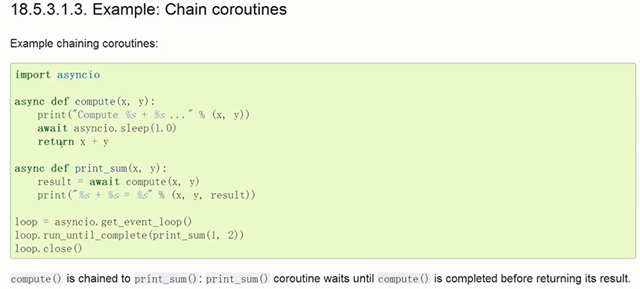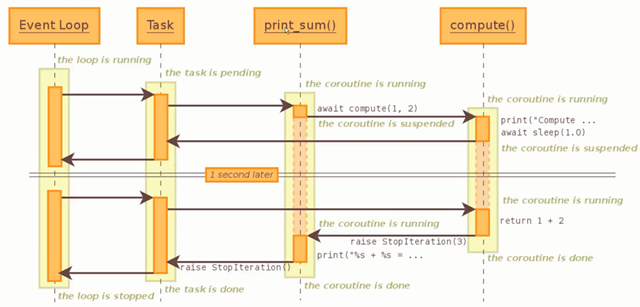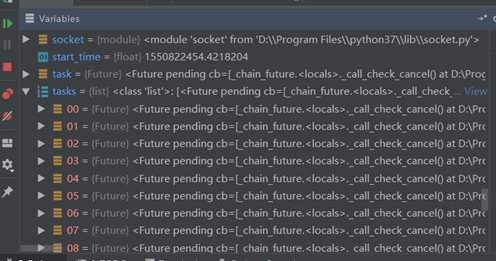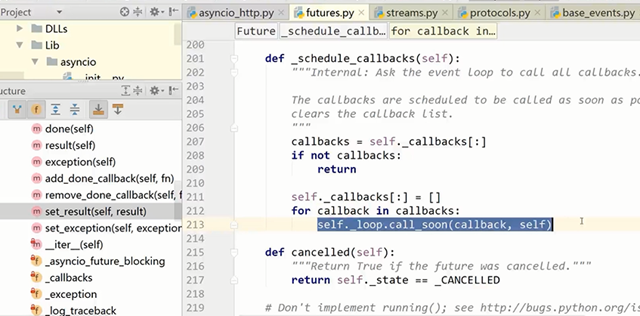13.1 事件循环
asyncio
包含各种特定系统实现的模块化事件循环
传输和协议抽象
对TCP、UDP、SSL、子进程、延时调用以及其他的具体支持
模仿futures模块但适用于事件循环使用的Future类
基于 yield from 的协议和任务,可以让你用顺序的方式编写并发代码
必须使用一个将产生阻塞IO的调用时,有接口可以把这个事件转移到线程池
模仿threading模块中的同步原语、可以用在单线程内的协程之间
事件循环+回调(驱动生成器)+epoll(IO多路复用)
asyncio是python用于解决异步io编程的一整套解决方案
tornado、gevent、twisted(scrapy, django channels)
torando(实现web服务器), django+flask(uwsgi, gunicorn+nginx)
tornado可以直接部署, nginx+tornado


import asyncio import time # 不再这使用同步阻塞的time async def get_html(url): print("start get url") await asyncio.sleep(2) # time.sleep(2) 不要这样写 print("end get url") if __name__ == "__main__": start_time = time.time() loop = asyncio.get_event_loop() tasks = [get_html("http://www.imooc.com") for i in range(10)] loop.run_until_complete(asyncio.wait(tasks)) print(time.time() - start_time) """ start get url start get url start get url start get url start get url start get url start get url start get url start get url start get url end get url end get url end get url end get url end get url end get url end get url end get url end get url end get url 2.001918077468872 """


import asyncio import time from functools import partial # 偏函数 async def get_html(url): print("start get url") await asyncio.sleep(2) return "lewen" def callback(url, future): print(url) print("send callback email to lewen") if __name__ == "__main__": start_time = time.time() loop = asyncio.get_event_loop() # 事件循环 # task = asyncio.ensure_future(get_html("http://www.imooc.com")) # 任务的两种不同写法 task = loop.create_task(get_html("http://www.imooc.com")) task.add_done_callback(partial(callback, "http://www.imooc.com")) loop.run_until_complete(task) print(task.result()) """ start get url http://www.imooc.com send callback email to lewen lewen """


import asyncio import time async def get_html(url): print("start get url") await asyncio.sleep(2) print("end get url") if __name__ == "__main__": start_time = time.time() loop = asyncio.get_event_loop() tasks = [get_html("http://www.imooc.com") for i in range(10)] # loop.run_until_complete(asyncio.gather(*tasks)) loop.run_until_complete(asyncio.wait(tasks)) # print(time.time()-start_time) # gather和wait的区别 # gather更加高层 high-level 分组 group1 = [get_html("http://projectsedu.com") for i in range(2)] group2 = [get_html("http://www.imooc.com") for i in range(2)] group1 = asyncio.gather(*group1) group2 = asyncio.gather(*group2) # group2.cancel() #取消 loop.run_until_complete(asyncio.gather(group1, group2)) print(time.time() - start_time)
13.2 协程嵌套
13.3 call_soon、call_later、call_at、call_soon_threadsafe


import asyncio def callback(sleep_times, loop): print("success time {}".format(loop.time())) def stoploop(loop): loop.stop() # call_later, call_at if __name__ == "__main__": loop = asyncio.get_event_loop() # 马上执行队列里面的task # loop.call_soon(callback, 4, loop) # loop.call_soon(stoploop, loop) # call_later() 等待多少秒后执行 # loop.call_later(2, callback, 2, loop) # loop.call_later(1, callback, 1, loop) # loop.call_later(3, callback, 3, loop) # call_at() 在某一时刻执行 now = loop.time() loop.call_at(now+2, callback, 2, loop) loop.call_at(now+1, callback, 1, loop) loop.call_at(now+3, callback, 3, loop) loop.run_forever() # loop.call_soon_threadsafe()
13.4 ThreadPoolExecutor+asyncio
# 使用多线程:在协程中集成阻塞io # 数据库等阻塞式IO import asyncio from concurrent.futures import ThreadPoolExecutor import socket from urllib.parse import urlparse def get_url(url): # 通过socket请求html url = urlparse(url) host = url.netloc path = url.path if path == "": path = "/" # 建立socket连接 client = socket.socket(socket.AF_INET, socket.SOCK_STREAM) # client.setblocking(False) client.connect((host, 80)) # 阻塞不会消耗cpu # 不停的询问连接是否建立好, 需要while循环不停的去检查状态 # 做计算任务或者再次发起其他的连接请求 client.send("GET {} HTTP/1.1\r\nHost:{}\r\nConnection:close\r\n\r\n".format(path, host).encode("utf8")) data = b"" while True: d = client.recv(1024) if d: data += d else: break data = data.decode("utf8") html_data = data.split("\r\n\r\n")[1] print(html_data) client.close() if __name__ == "__main__": import time start_time = time.time() loop = asyncio.get_event_loop() executor = ThreadPoolExecutor(3) # 线程池 tasks = [] for url in range(20): url = "http://www.baidu.com/s?wd={}/".format(url) task = loop.run_in_executor(executor, get_url, url) # 将阻塞的放到执行器里面 tasks.append(task) loop.run_until_complete(asyncio.wait(tasks)) print("last time:{}".format(time.time() - start_time)) # 将线程池直接应用到协程里面
13.5 asyncio模拟http请求
# coding=utf-8 # asyncio 没有提供http协议的接口 aiohttp import asyncio from urllib.parse import urlparse async def get_url(url): # 通过socket请求html url = urlparse(url) host = url.netloc path = url.path if path == "": path = "/" # 建立socket连接 reader, writer = await asyncio.open_connection(host, 80) writer.write("GET {} HTTP/1.1\r\nHost:{}\r\nConnection:close\r\n\r\n".format(path, host).encode("utf8")) all_lines = [] async for raw_line in reader: data = raw_line.decode("utf8") all_lines.append(data) html = "\n".join(all_lines) return html async def main(): tasks = [] for url in range(20): url = "http://www.baidu.com/s?wd={}/".format(url) tasks.append(asyncio.ensure_future(get_url(url))) for task in asyncio.as_completed(tasks): result = await task print(result) if __name__ == "__main__": import time start_time = time.time() loop = asyncio.get_event_loop() loop.run_until_complete(main()) print('last time:{}'.format(time.time() - start_time))
13.6 future和task
future 结果容器
task 是 future 的子类,协程和future之间的桥梁,启动协程
13.7 asyncio同步和通信


total = 0 async def add(): # 1,dosomething1 # 2.io操作 # 1.dosomething3 global total for i in range(100000): total += 1 async def desc(): global total for i in range(100000): total -= 1 if __name__ == "__main__": import asyncio tasks = [add(), desc()] loop = asyncio.get_event_loop() loop.run_until_complete(asyncio.wait(tasks)) print(total)
13.8 aiohttp实现高并发爬虫







 本文详细介绍了Python的异步编程库asyncio的使用方法,包括事件循环、回调、任务管理、协程嵌套、定时器、线程池集成、http请求模拟及并发爬虫实现,展示了如何利用asyncio提升程序效率。
本文详细介绍了Python的异步编程库asyncio的使用方法,包括事件循环、回调、任务管理、协程嵌套、定时器、线程池集成、http请求模拟及并发爬虫实现,展示了如何利用asyncio提升程序效率。




















 6047
6047

 被折叠的 条评论
为什么被折叠?
被折叠的 条评论
为什么被折叠?








